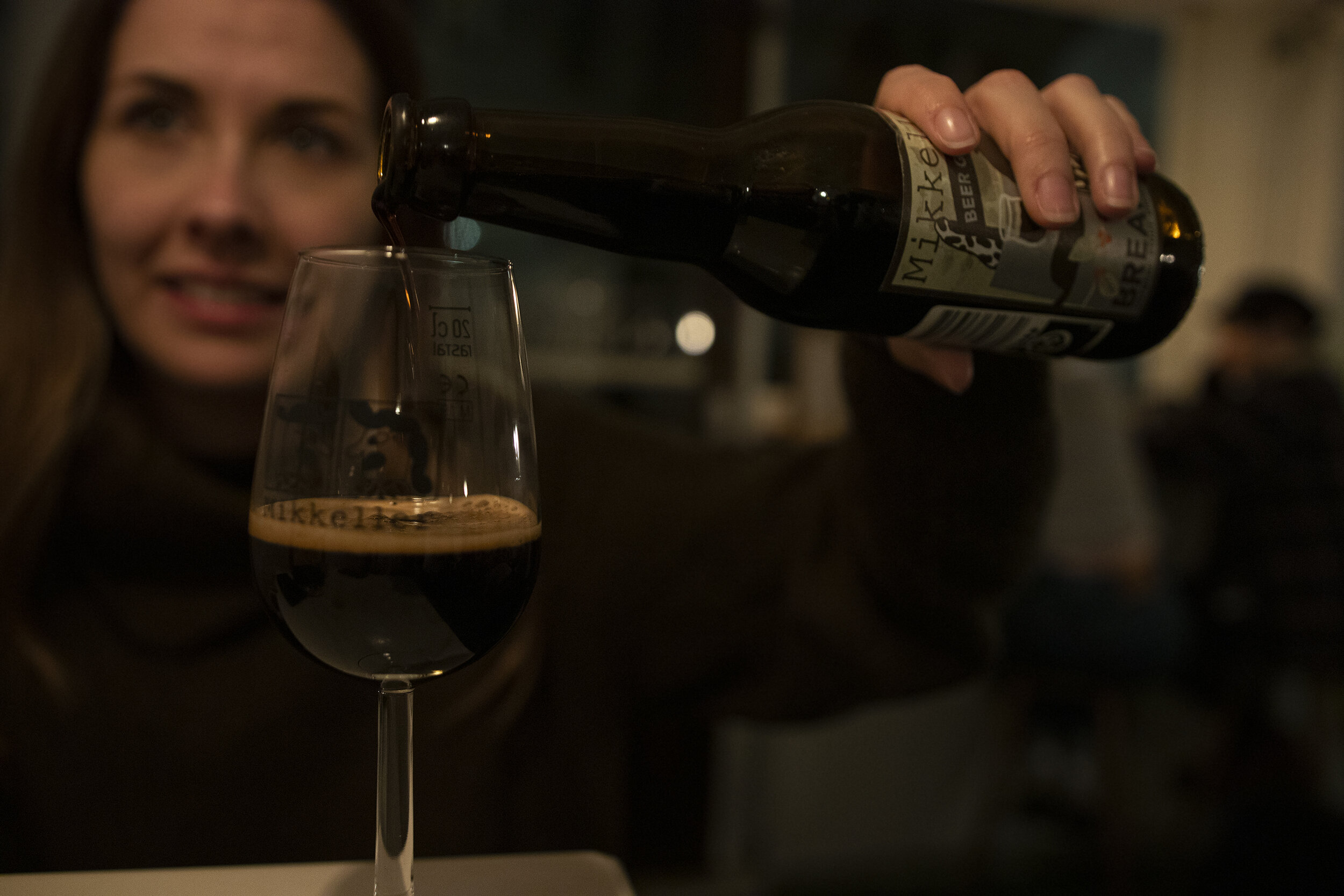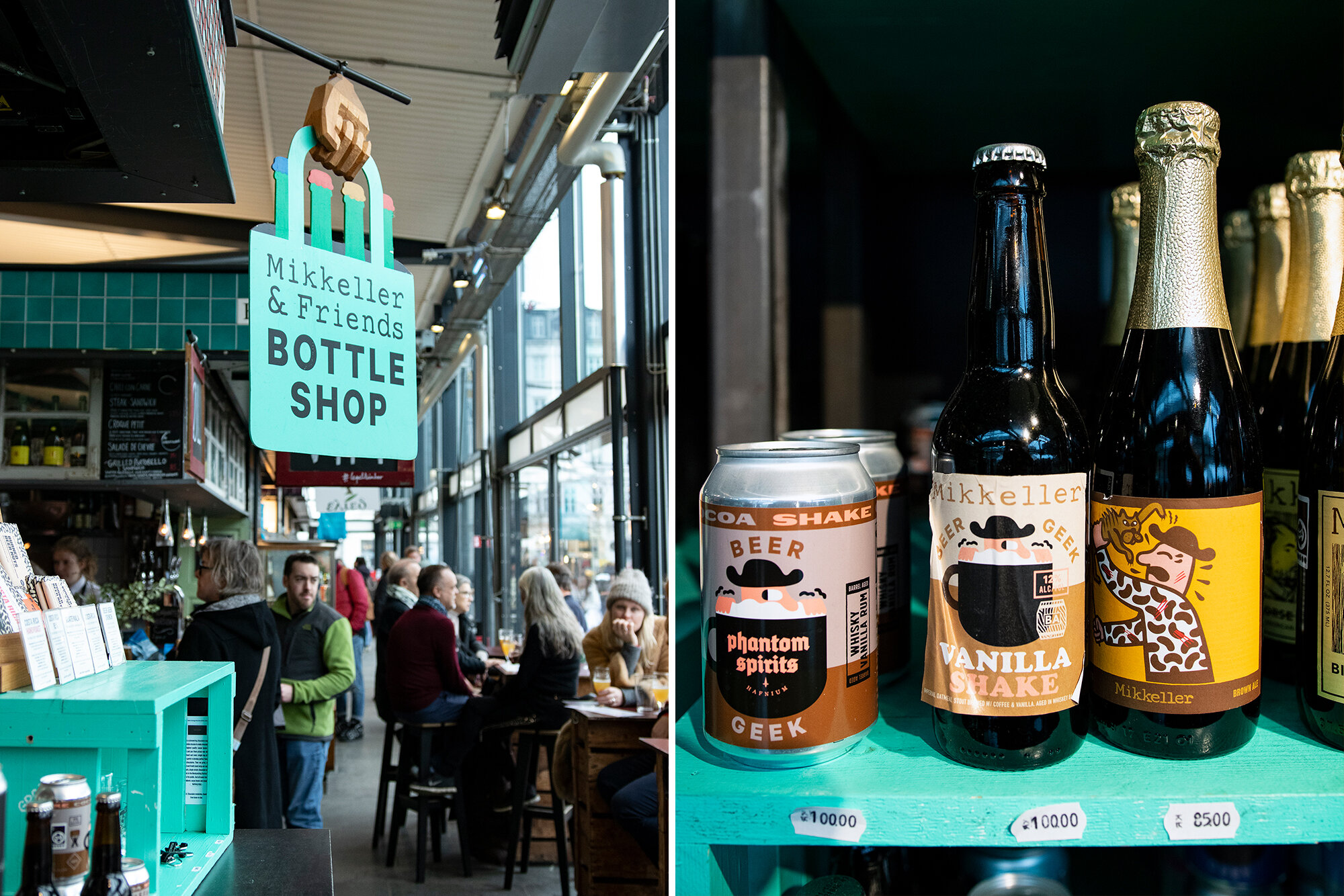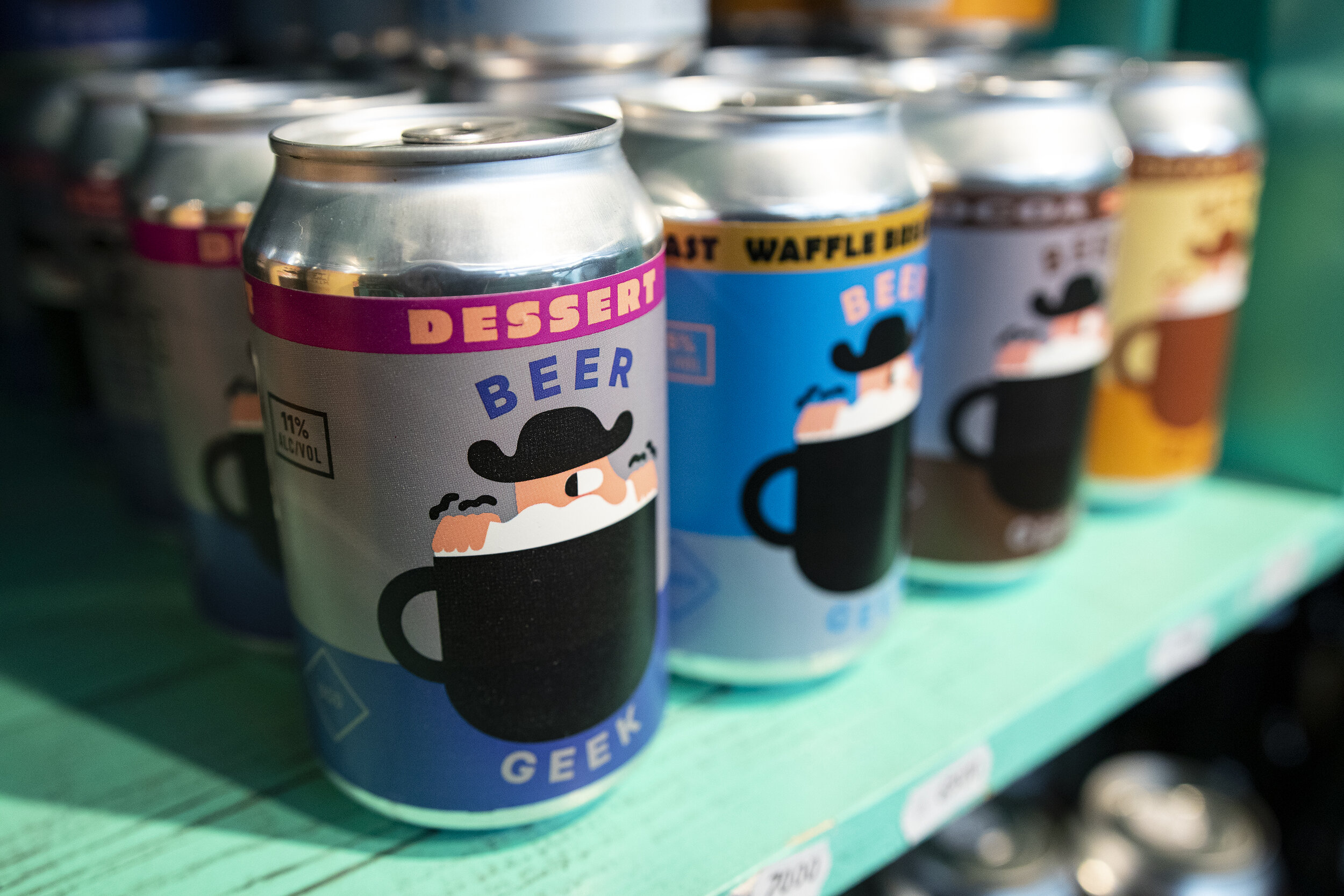Copenhagen has burned to the ground at least three times. Even after the last great fire, in 1807, the port city remained in constant flux as its significance as gatekeeper to the Baltic Sea ebbed and flowed.
Reinvention is part of Copenhagen’s identity. In the last few decades the city has prospered, thanks in part to an economy based on pharmaceuticals, green energy, and IT. Today it is known for its quality of life and as the capital of all things “New Nordic”; its music, art, food, and drink are celebrated around the world. As the docklands deindustrialized, creatives were quick to take over and transform derelict sites, kicking off a new phase of reinvention.
And speaking of: as far as reinventions go, the story of Mikkel Borg Bjergsø, the founder of Mikkeller, is difficult to top.
Today, Copenhagen is Mikkeller’s town. I met Bjergsø around the corner from Mikkeller Baghaven, a bar and blendery that looks out across the harbor to the oldest part of the city, but we could have met pretty much anywhere and been on his turf. Craving tacos? Head to La Neta. After some barbecue? Get to Warpigs. Need some nourishing noodles? There’s Ramen to Biiru. Mapo tofu, perhaps? There’s the aptly named Vesterbro Chinese Food. Mikkeller even has Øl & Brød, a bar whose name translates to “Beer and Bread,” and which is dedicated to traditional Danish open-faced sandwiches.
In all the brewery owns around 20 bars, shops, and restaurants in the Danish capital, two of which are breweries themselves. It’s one hell of an empire for a guy who was still a teacher in 2009, and its origins can be traced back to the release of one beer: Beer Geek Breakfast.
Bjergsø never really meant to found a brewery, or at least that’s the way he tells it. He and his friend Kristian Keller were messing around with homebrewing, mostly making the American styles Bjergsø had discovered on trips across the Atlantic. Occasionally they’d sell a few illicit batches to a local bottle shop to get feedback from beer geeks, but it was never intended to become a commercial venture. That all changed when they brewed their first Export Stout around 2006.
“We tasted it after and thought it was OK but a bit boring,” says Bjergsø. “I’d recently had AleSmith Speedway Stout and knew that Peter Zien [founder of AleSmith Brewing Company] had added coffee, so I asked him how to add it to a beer. He said to brew a French press and just pour it in after fermentation.”
Without much expectation, the pair brewed a second batch and added the freshly brewed coffee. According to Bjergsø, the result was a “revelation.” The original recipe was dry, with a heavily roasted character, so the coffee added depth and fruitiness, enhancing the licorice and dark chocolate notes. As with all the batches they liked, they sold a few cases to the bottle shop in the hope that people would review it on RateBeer. This time, the response was remarkable.
“In 2006 it was voted the best Stout in the world, off 100 bottles—and because of that beer we also got voted, like, the 30th best brewery in the world. I mean, obviously we weren’t a brewery, we were just two guys homebrewing!”
The problem, if it could be called a problem, was that the world’s importers didn’t know that. Straight after the RateBeer Awards were announced—Mikkeller actually came 37th—no fewer than six American distributors contacted Bjergsø and Keller to secure the rights to their beer. For Will Shelton of Shelton Brothers Importers, it was a bit of a blur.
“Scandinavian brewers were starting to get a bit of buzz in the industry,” he recalls. “I was duly dispatched to that year’s Copenhagen Beer Festival. One of the beers [Mikkeller] showed at the fest was an IPA brewed to a theoretical IBU count of 2,006. To be honest, I don’t even remember trying Beer Geek Breakfast that day, but the name had an undeniable appeal.”
Impressed by the pair and their outsize ambition, Shelton ordered a full shipping container of beer. Now there really was a problem. You couldn’t fill a shipping container with beer from a homebrew set-up. Mikkeller needed a brewery, and fast.
“I’d actually given them their 100-liter mash tun just a few weeks before,” says Mike Murphy, brewmaster at Lervig in Stavanger, Norway.
Back then, Murphy was brewing at Gourmetbryggeriet in nearby Roskilde, and had met Bjergsø through the Danish beer scene.
“I even said, ‘You can’t make beer in your kitchen and sell it!’ Next thing I know, Mikkel was asking for 3,000 liters of a couple of different beers, including Beer Geek Breakfast, to sell to Shelton Brothers. I guess I was impressed.”
Murphy offered to help immediately. Born and raised in Philadelphia, he had been drinking American-style craft beer for much of his life, and was bored with the safe Blondes and Red Ales he was forced to brew at Gourmet. Mikkeller’s recipes were more like the beers he wanted to make, so he set about brewing Beer Geek Breakfast, while Bjergsø and Keller spent a sleepless, jittery night French-pressing about 40 liters of coffee at a local cafe. Still, Murphy had his doubts.
“I even said, ‘You can’t make beer in your kitchen and sell it!’ Next thing I know, Mikkel was asking for 3,000 liters of a couple of different beers, including Beer Geek Breakfast, to sell to Shelton Brothers. I guess I was impressed. ”
“I’d never seen a Stout recipe with so much roasted malt and I thought it was way over-the-top, but I stuck to the recipe,” he says. “I was expecting it to be undrinkable and it was pretty rough the first week or two in tank, but after about three weeks … well, it was pretty good.”
According to the internet, “pretty good” was a gross understatement. Beer Geek Breakfast, as it became known, remained near the top of the style’s RateBeer rankings, and was soon joined by additional heavyweights, including Big Bad Barley Wine and several single-hop IPAs. By 2007, the brewery had climbed the rankings to be named the fifth-best in the world—edging out Westvleteren and Russian River Brewing Company—despite the fact that it had no brewing facilities of its own.
Sales were growing too, with every batch going straight out the door, and much of it abroad. The perceived wisdom would have been to build a brewery to keep up with demand and keep production costs down, but Bjergsø and Keller continued contract brewing. Neither wanted to quit their day jobs, and they also worried that opening a physical brewery would compromise the initial idea of Mikkeller.
“We didn’t want to take a big loan,” says Bjergsø, “because then you have to sell lots of beer, and to sell lots of beer in Denmark back then you had to brew something like Carlsberg. We wanted to brew the beers we wanted to drink, not what the customers were demanding.”
Rather than tackle the lifestyle challenges and financial difficulties that owning a brewery presents, they decided to confront a very different issue—the stigma around contract brewing. In 2006 such a practice was the preserve of the multinationals, purely used to reduce transport time and costs. It was seen as a compromise by pretty much all brewers, but to craft brewers it was even worse—many wouldn’t consider you a brewery at all if you didn’t make it yourself.
“We didn’t want to take a big loan, because then you have to sell lots of beer, and to sell lots of beer in Denmark back then you had to brew something like Carlsberg. We wanted to brew the beers we wanted to drink, not what the customers were demanding.”
“Back then, contract brewing was looked down upon,” says Bjergsø. “I had a lot of discussions with brewers around it. I did a tasting in Sweden once and some brewers came down to trash talk me because I was a contract brewer—they didn’t understand how you can call yourself a brewer if you’re not in the brewery. But you still call yourself a fashion designer if you don’t make the clothing. It’s the modern world.”
Luckily for Bjergsø, the public either didn’t know or didn’t care. Business kept booming, Mikkeller’s reputation kept growing, and the orders kept coming in. The founders’ new double lives didn’t suit Keller, who left the brewery to focus on his career as a journalist in 2007, but Bjergsø was having too much fun to stop. The next year he had four beers in the RateBeer top 100, and was waking up at 2 a.m. each day to do the brewery work before heading to school. Ultimately, though, something had to give.
“I worked like crazy. All the time. Non-stop,” he says. “I actually did an interview for a teacher’s magazine where I said I’d quit beer before I quit teaching, but then three months later I was no longer a school teacher! The brewery had gone crazy.”
In 2009, Bjergsø gave up his teaching job and took the brewery full-time, joining a team of employees he had already taken on. As Mikkeller had grown, so had the range of Beer Geek beers. Beer Geek Brunch was an imperial version of the brewery’s name-making Stout, at a hefty 10.9% ABV, while Beer Geek Brunch Weasel was the same beer made with Kopi Luwak, a cringingly expensive Indonesian coffee made from beans passed through the digestive system of a civet. Outshining even that concept, however, was Beer Geek Vanilla Shake.
Made with coffee and vanilla sugar and brewed to a massive 13%, the beer sounds like a statement of intent. In truth, its creation was an accident. By this time, Murphy had moved on to Lervig, but had taken the Mikkeller brewing contract with him. Having brewed so many of the original beers, he knew better than anyone what Bjergsø was after, but exchanging recipes via email means wires get crossed sometimes.
The first brew at Lervig was to be a batch of George, an Imperial Stout that Bjergsø wanted to add vanilla to.
“I asked Mikkel how much vanilla sugar he wanted to add, and he sent me an email with, like, 1 gram per liter or something,” says Murphy. “I only had 20kg at the brewery but I needed 30kg, so I thought, ‘I’ll add the 20kg and see what happens.’ And I was like, ‘Oh God, I ruined this thing!’”
Far from being underwhelming, the vanilla flavor was overpowering and sweet. Still, Murphy had been through it all before with Mikkeller. He followed the recipe to the letter, dutifully bottled the beer, and sent it to Denmark hoping for the best.
“Mikkel emailed back and said, ‘How much vanilla did you put in this thing?!’ So I just copied and pasted his email back to him, and he was like, ‘Oh! I meant per hectoliter!’ So he meant like 3kg, and I would have put 30kg in if I’d had it.”
Bjergsø decided that, while it definitely wasn’t George, it was still a delicious and exciting beer. All it needed was a rebrand, which Bjergsø did by hand-sticking hurriedly designed Beer Geek Vanilla Shake labels right on top of the George ones.
“A month later Mikkel was like, ‘Look at RateBeer.’”
Beer Geek Vanilla Shake is still one of the highest-rated Stouts on the internet, whichever app or site you use. Released around the same time as Cigar City Brewing’s staggeringly popular Hunahpu’s Imperial Stout, it was, perhaps, a foreshadow of the Pastry Stout craze to come. Both beers have certainly inspired a lot of adjunct brewing on their respective sides of the Atlantic. But Bjergsø prefers not to see it that way, and says he makes sure that all his Beer Geek beers are well attenuated and retain some balance. Perhaps that has gotten away from him recently—waffles, maple, and lactose are all found in some of the newer versions—but the originals still retain their heavy roasted malt character and dry, coffee finishes.
“We have made a lot of different versions because people love it,” he admits. “In some ways you could call Vanilla Shake a Pastry Stout, but it’s still very drinkable. I always try to do that with my Imperial Stouts, to find somewhere in between the gimmicky pastry stuff and something more complex.”
“What I changed was turning contract brewing into a positive instead of a negative. I can brew spontaneous fermented beer in Belgium, the best Imperial Stouts in Norway, Kölsch in Cologne, and fresh IPAs on the West Coast. ”
As for his role in making contract brewing a legitimate business model, Bjergsø is more open to taking credit. While his business model was born of necessity, he unlocked the kind of flexibility most brewers can only dream of. Contract brewing is now a model that has been adopted by over 100 Danish breweries—just under half the country’s total—as well as thousands more around the world.
“What I changed was turning contract brewing into a positive instead of a negative,” he says. “I can brew spontaneous fermented beer in Belgium, the best Imperial Stouts in Norway, Kölsch in Cologne, and fresh IPAs on the West Coast. It’s an extremely good business model because it allows somebody without a lot of money to try something, and if it doesn’t work it doesn’t cost anyone anything.”
Of course, now Mikkeller does have a lot of money, and paradoxically it spends most of it planting roots around the world in the form of new breweries. It started with the launch of Warpigs, a collaborative brewpub and barbecue restaurant with Indiana’s 3 Floyds Brewing Co., in the warehouse district of west Copenhagen. But true to his international outlook, Bjergsø was already thinking bigger. After a decade spent proving himself and his methods to the beer industry, Bjergsø has turned towards bringing production in house.
“There is a lot of competition now and it’s getting more difficult to not care about price. We always used to say, ‘The beer costs what it costs to make.’ That’s changing now. We’re not compromising on the beer, but we’re opening breweries so we can produce that beer for less money.”
Not only does it mean extra profit margin, it means that he can supply fresh and even locally inspired beer to his core markets. His breweries in San Diego and New York focus on American IPA styles, while his soon-to-open British brewpub will even brew cask beer.
For the first time in Mikkeller’s history, Bjergsø is making beer for the local audience in his home city. It’s on the industrial wasteland of Refshaleøen, where we shared a beer, that he has his most local project yet. Mikkeller Baghaven is a wild-beer-focused brewery, using local fruits, yeasts, and sensibilities to make beer that almost tastes of the place it’s from: Mikkeller Town, Denmark.



























